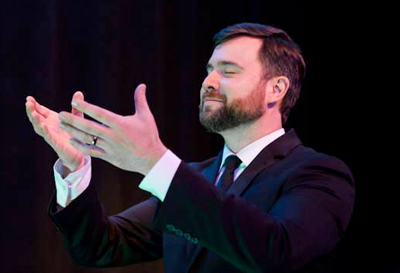by Daniel Hathaway

We spoke by telephone last week with Seraphic Fire’s founder and artistic director Patrick Dupré Quigley, who was already in Cleveland on another assignment with the Cleveland Orchestra.
Daniel Hathaway: I just discovered that you’re serving as cover conductor for this week’s St. John Passion performances.
Patrick Dupré Quigley: It’s been sort of a Stravinsky-Bach sandwich working on Threni last week, then the St. John this week, then Threni again next week. When you do things like that, you begin to realize all the parallels between the works.
DH: Congratulations on Seraphic Fire’s fifteenth anniversary. I was blown away by the Choir’s performance at Oberlin in September of 2012. Now how did you and The Cleveland Orchestra come together?
PDQ: I’ve been coming to their Miami concerts for a long time. The classical music field is about as big as a backyard pond, and in a way, all roads lead to Cleveland. I was here last year covering Messiah and the year before observing Jane Glover. Some of the members of the Orchestra have played in Seraphic Fire, so there’s been a lot of cross-pollination over time. Members of the artistic staff have heard our concerts. They’re very willing to reach out and treat Miami as another musical community they’re part of.
DH: Whose idea was it to perform Threni?
PDQ: It was Cleveland’s idea. Mark Williams is one of the best programmers and big-picture artistic planners in the business. At the time the piece was written, its technical demands far outpaced the abilities of orchestras and choirs. Mark had the foresight to recognize that between TCO, the Chorus, and SF, we now had the ability to perform it the way Stravinsky heard it in his mind.

PDQ: We know nothing about its premiere in Venice, but the Parisian debut started a long-term, letter-writing blame game between Stravinsky, Robert Craft, and Pierre Boulez. We’ve been preparing the piece for six months. It’s a marathon rather than a sprint for a singer, and a long period of conditioning is required to put the music into your muscles rather than into your mind. Stravinsky doesn’t make the music easy for anybody. He uses crazy meters and a very different way of treating twelve-tone music. In many ways, the piece is the child of a love affair between Les Noces and Oedipus Rex. It has all of the rhythmic complexity of a 1940s Stravinsky work with all the harmonic complexity of an early 20th-century dodecaphonic piece.
It also wants to be a neo-Renaissance work by removing barlines. There’s a challenge even rehearsing it. You can’t even say, “Let’s start at measure 93,” because there are no measures. But it is melodic — after a while you start singing the themes to yourself. Stravinsky had flirted with twelve-tone music before, but this was a real statement.
DH: How are you dividing up the choral duties?
PDQ: The Orchestra Chorus is taking the choral parts, while a sextet of singers from Seraphic Fire acts as a semi-chorus throughout the piece. Substantial portions of the work are written for tenors and basses in an imitative, polyphonic style but in twelve-tone language. There’s also a lot of Russian basso profundo work. It’s really a piece for a Romantic early 20th-century orchestra and chorus and a Renaissance sextet. It’s also a Venetian piece — the sextet is very similar to how the eight soloists in the Monteverdi Vespers function. In many ways, they represent Stravinsky’s voice, the voice of the Prophet. It’s similar to the way Tallis and other composers set the Lamentations. A large group sings the Hebrew letters that begin each stanza of Jeremiah’s poetry, while a small group sings the text of the Lamentations.
DH: You’ll be conducting your own Cleveland Orchestra concert this summer — the Mozart Requiem.
PDQ: That’s still sort of surreal. The piece is an intellectual icon in many ways: here are the last pen strokes from a composer of a level of genius that would take quite some time for us to see again. The thought that it might be able to be passed off as someone else’s work is pretty crazy. The Requiem and the second-act finale of Figaro are two of the pieces that took music by the ankles, turned it upside down, and shook all the change out of its pockets.
It’s an intense experience whenever you get to conduct that work. I’ve messed around with commissioning my own completion of the piece, but in the end it’s a work that you come to with reverence and a sense of responsibility. The idea that twenty-five years ago someone made a movie about this piece that won an Oscar, and it was so popular that there were pop references to it at the time — that sort of phenomenon means you have no option but to do right by this music.
Published on ClevelandClassical.com March 13, 2017.
Click here for a printable copy of this article



